Not Part II.2, III. OK, on to what I thought would be the subject of visualizations, namely .380 firearms’ effect on rounds’ effectiveness. Still, having stumbled on this non/light/high expander breakout, I continue to find uses for it in this round.
This is a bit of a 3 bears post, so let’s get on to the first wrong bear: FMJ and other non-expanding rounds.
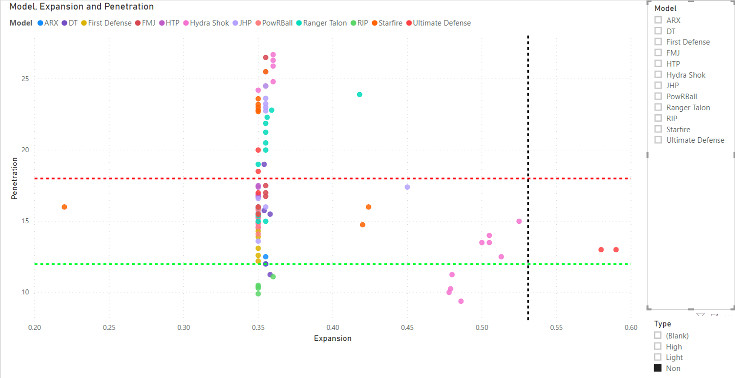
Again ‘non’ was chosen because the median of each type was non-expanding. You can see some of the Hydra Shok (from three testers) and two of the Ultimate Defense (from one test with a Diamondback) were doing pretty well. Tl;dr: If those interest you, try them in your firearm for function and performance. And a side note: debuting this spring, Federal is introducing their “Hydra Shok Deep” in .380. Looking forward to seeing people test those.
Other than that, I’d discount this whole class except to say, again, they certainly get the penetration part done, and then some, and so if that’s your angle, just buy plain old FMJ. That’s not my recommendation, but there it is.
OK, now on to the other bad bear, the ‘high expander’ rounds.
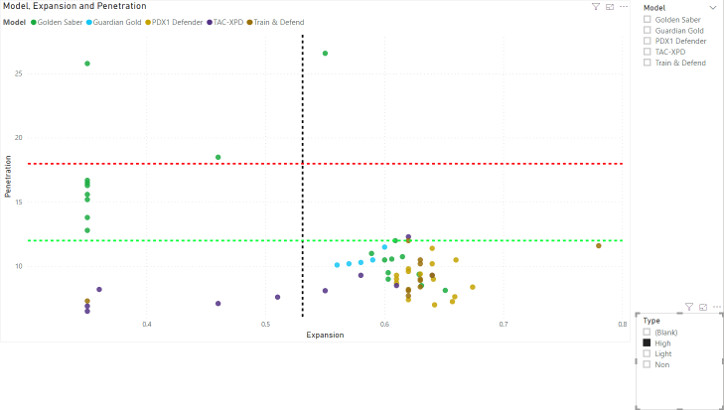
You can clearly see the variations on the theme here, but really as a whole you can expect a good sized hole, and without putting too fine a point on it, you’re kinda hoping it doesn’t stop short. It’s kind of unnerving that the Saber and TAC-XPD are so inconsistent between testers. The PDX1 and Train and Defend have the virtue of being very consistent (the Guardian Gold only has one test of 5 rounds from a G42). It’s not worth putting more graphs up just to tell you that when mapping these by barrel length they don’t really vary. Not really a ‘bad’ bear after all! The only caveat is that we chose the FBI spec as our benchmark, and they’re not really there.
OK, so did I write all this just to agree with the oft-cited Shooting the Bull 410 videos? Let’s see.

Again, the .380 is not a duty round. None of these drop in at perfect 12″-18″ penetration with full expansion, but they’re not designed to (or they are, in their 9mm configurations, and .380 appeared a bit of an afterthought?) FBI spec emphasizes penetration first and expansion second, and these have that same priority. There are a lot of them though, so this is where the firearm plays into things. I’m going to pick three to make some points.
Let’s start with the almost incumbent winner, the XTP (at least you’ll get that answer and a citation if you ask on almost any forum about .380 ammo).
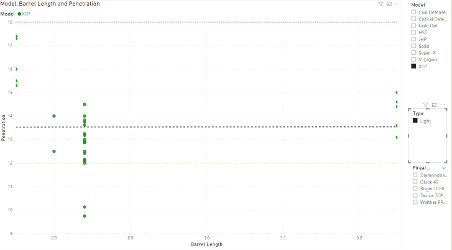
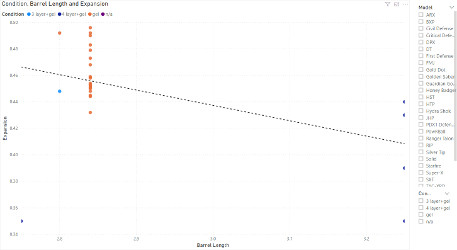
In the interest of space, I posted these smaller, but in short: XTP seems to work the same across barrel lengths, and penetrates more (and expands less) through cloth. Some inconsistency (see the left side) with the pocket pistols, so check with yours…
Now for the favorite of nearly all 9mm respondents, the HST (in 99gr ‘micro’ for .380, though)
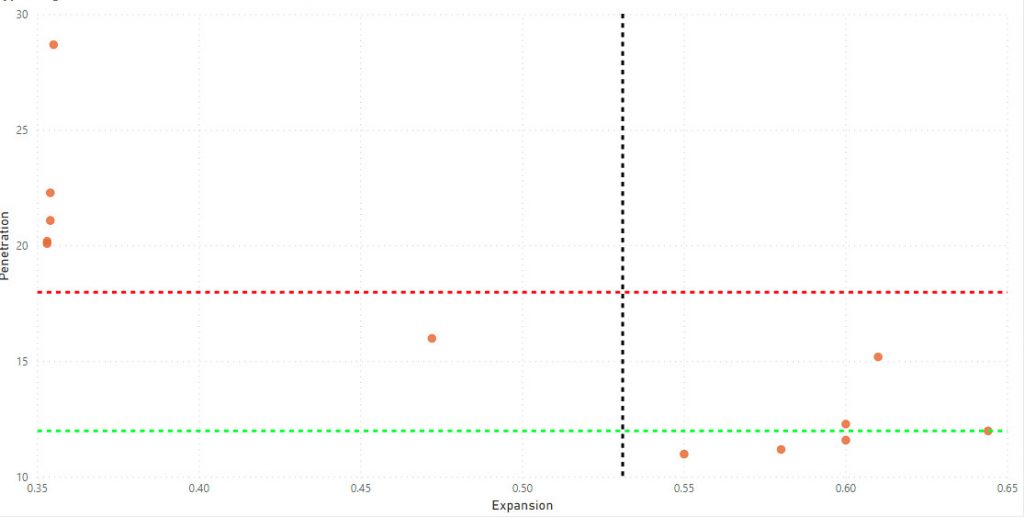
This graphic uses the subset of our expansion/penetration matrix but only for the HST rounds. Why? Well, there’s only 14 rounds in my sample set, and two of those only have FPS recorded. It’s not possible to make an accurate assessment of how HST performs with short and long barrels with this little data.
Worse yet, five of the 12 dots on this chart are all non-expanders. They also happen to be from one source (Lucky Gunner, using a Glock 42). I have no explanation about why they had such odd results. The remainder, though … 3 in the perfect zone, 3 just shy of perfect penetration, and one with plenty of penetration and light expansion. So promising! So few samples! Someone, please, stop shooting oranges and ribs and put some of this HST into gel, with a caliper and a ruler.
Now for the round that provoked so many sad faces across YouTube videos: Hornady’s Critical Defense. This one has a polymer plug in the nose to both inhibit clogging and provoke ‘controlled expansion’ (and yes, that’s squarely in what I’d call ‘light’ and they mapped that way). Did it work?
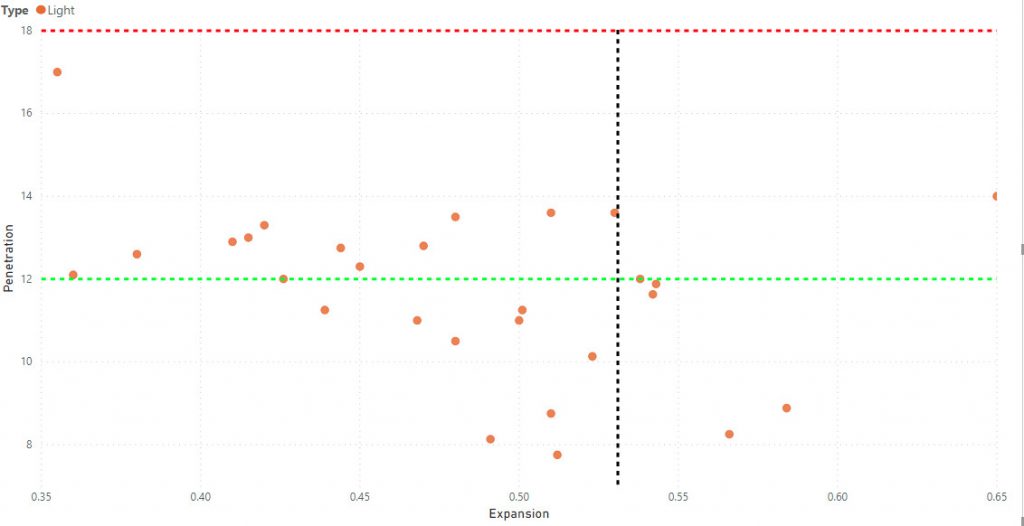
This doesn’t look bad! Only a few in the goldilocks zone, but at least half beyond the 12″ mark. Clearly, penetration correlates opposite to penetration, though. And yet … on YouTube, all we see are (FBI-spec) failures. What’s going on? Two more pictures explain.
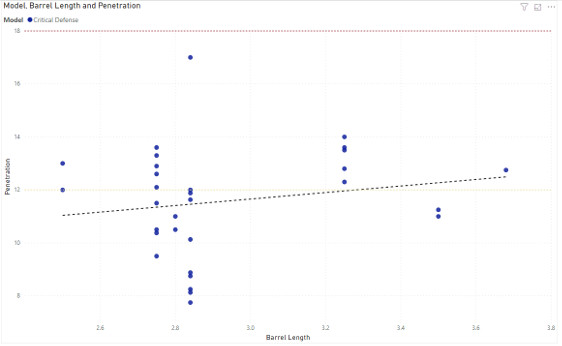
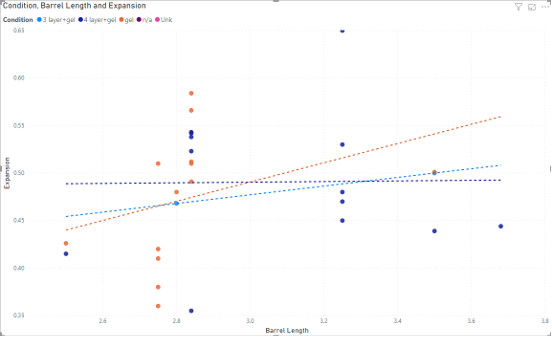
Lots of lines everywhere. The first one shows that HCD improves in penetration as barrel length increases; there’s a clear delineation between the .380 pocket pistol lengths (your LCPs, Picos, TCPs) and the ones which are like subcompact 9s (G42, Walther, Bersa Thunder). I didn’t grab a FPS trend because it correlates exactly the same. The HCD is a light shooter and isn’t making its ideal velocity out of sub-3″ barrels.
The second demystifies the expansion. The gel-only shots vary widely on expansion, which increases a lot by barrel length; with denim barrier, it’s very consistent and mild. When the polymer plug gets to do its job, it works.
Conclusion on the Hornady Critical Defense: I don’t recommend it for pocket pistols; should be great in subcompact size guns. I should temper that a bit. It’s actually OK; but it comes at a premium price, and for pocket pistols the XTP is better for less.
Frankly, while one could tinker with each ammo choice, and maybe you the reader would like another dozen graphs. Not today. I have one more stat, and that’s enough to make a solid recommendation. Based on one site that claims to have figures for the FBI scoring at 70% penetration (in the ideal range, with almost nothing for < 12″ and sharp drops for >18″), 20% expansion, and 10% consistency, I composed a faux FBI score for each round. There’s no ‘consistency’ score because I was scoring each round so that’s a sample size of 1 and no standard deviation… so really it’s 7/9ths and 2/9ths.
Anyway, I was prepared to throw all this into a decision tree model and see what predicts closest adherence to the FBI spec. Remember, penetration weighted overwhelmingly here. Fortunately, my visualizer now has a rudimentary modeler built in, and it quickly came up with an answer. By a good margin, the XTP rounds win (6.15 average/9, vs all rounds being an average 3.15). Generic JHPs, Golden Saber, SIG V-Crown, HST, and Critical Defense made the 2nd tier. Generic FMJ and the Civil Defense round were worst, for opposite reasons (FMJ goes straight through, CD makes hardly any impression).
So there’s the recommendation:
- If you have a pocket .380 (anything with a barrel < 3″), begin and end your search with the XTP bullet. They’re relatively inexpensive, are loaded by several manufacturers, penetrate in the right range, and expand mildly. (Then practice!)
- For the sub-compact .380s, there’s no clear winner, but XTP, HST, and HCD rock. I am personally a fan of the HST here, but that’s in my firearm knowing it’s 100% reliable and pushes that 99gr bullet well. (Then practice!)
- If you live in Florida or Hawaii maybe consider some of those rounds I tagged as high expanders. Grudgingly, I have to accept there’s something to that 12″ standard, and a big wide hole that stops the threat a couple minutes after he kills you is not too helpful. (But practice!)
And lastly; yes, .380 ACP works. If you’re an officer and need to stop threats behind steel car doors, wood, and auto glass as part of your job, no, but for the general public, yep.
I’d planned a part IV with deeper analytics but, unless I find a reason, that’s off for now. Might be fun to develop a predictor for the missing data on some rounds, but the existing data drove conclusions that are compelling to me, and the time is better spent developing better shot placement…
According to DOJ crime statistics, guns are used somewhere between 235,700 and 2,500,000 times per year to stop crimes, 98% of the time without a shot being fired.
In other words, a .22 is as good as a Howitzer 98% of the time.
Source: GunFacts.info
https://www.gunfacts.info/pdfs/gun-facts/7.0/gun-facts-7.0-screen.pdf
Have you tried the Liberty 380 ammo withe a rated 1500 fps?
It seems that is a very good penetrating 380 round.
Bob,
None of these are my tests — all are other people’s published results on websites or video. I collected them all to form a large(ish) dataset. Since publication the number of people spending their $ and time to publish more results has drastically declined due to price/availability, but if I find more results I’ll include them. So far I only have this from Lucky Gunner: https://www.luckygunner.com/labs/self-defense-ammo-ballistic-tests/#380ACP. They averaged 9.32″ penetration with .388″ expanded diameter, in clear gel.
— Wererat
Hi,
I like 380 because I am getting old and can’t handle my 9mm
any longer, nor the mag refills.
Your analysis was okay, but unreadable for my also aging eyes.
Please resend in a larger format.
Bob
PS
Try Liberty 380 in one of your ballistics tests…fps amazing.